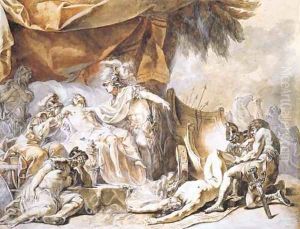Joseph-Barthelemy Le Bouteux Paintings
Joseph-Barthelemy Le Bouteux was a French painter and draftsman born in 1747, whose works are less known to the general public but hold significance in the study of 18th-century French art. His life spanned a period of great change in France, from the years before the French Revolution through to the Napoleonic era and the Restoration of the French monarchy.
Le Bouteux's artistic journey began in Paris, where he was trained in the rigorous academic style that dominated French art at the time. This education emphasized drawing from life and studying the works of the masters, aiming to achieve a high degree of realism and emotional expressiveness in art. Le Bouteux, however, was not just a product of his education. He brought to his work a distinctive sensitivity to the nuances of light and shadow, which gave his paintings a vibrancy and a sense of immediacy.
Throughout his career, Le Bouteux exhibited at the Salon, the official art exhibition of the Académie des Beaux-Arts in Paris. His submissions to the Salon, which included both historical and mythological subjects as well as more intimate portraits and landscapes, were well received, earning him a measure of respect among his contemporaries. Despite this, he never achieved the level of fame enjoyed by some of his peers. This may have been due in part to the political upheavals of his time, which disrupted the traditional art market and patronage systems.
Le Bouteux's works are characterized by their delicate handling of detail and a soft, muted color palette, which together create a sense of harmony and balance. His landscapes, in particular, show an appreciation for the beauty of the French countryside, rendered with a gentle realism that was ahead of its time. In his portraits, he displayed an ability to capture not just the physical likeness of his subjects, but also a hint of their inner life, a quality that aligns him with the psychological depth sought by later artists.
Joseph-Barthelemy Le Bouteux died in 1819, leaving behind a modest but compelling body of work. Though he may not be as widely recognized as some of his contemporaries, his contributions to French art provide valuable insights into the aesthetic shifts and cultural currents of his time. Today, his paintings can be found in various French museums, where they continue to be studied and appreciated for their quiet beauty and technical skill.
